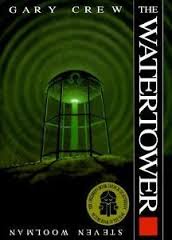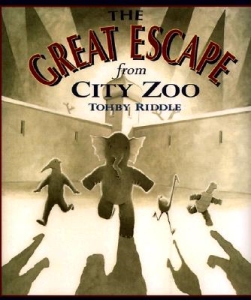2018 School Spending Survey Report
News from Down Under: Turning Heads
Picture books for older readers.
 Mixed public reactions frequently accompany award decisions. But when a picture book for older readers was named the 1995 Picture Book of the Year by the Australian Children’s Book Council, there was, according to one critic, downright “hostility.” That book, however, The Watertower, written by Gary Crew and illustrated by Steven Woolman, continues to attract interest — and readers. Crew, a prestidigitator of words, has managed to work his magic successfully on a variety of reading levels, with a number of his books receiving widespread critical acclaim (his novel Strange Objects, for instance, was the Australian Children’s Book of the Year in 1991 as well as an Edgar Allan Poe Award for Mystery Fiction nominee in the U.S.). The Watertower turned heads from the moment it was published — literally as well as figuratively. That’s because, to begin with, the reader must actually turn the book on its side to read it and then continue to turn it as the story progresses (or doesn’t, depending on your interpretation). According to one advocate, a high school English teacher, this actual turning/handling — along with the tantalizing clues to the story — is what hooks her student readers, particularly the less enthusiastic ones.
Mixed public reactions frequently accompany award decisions. But when a picture book for older readers was named the 1995 Picture Book of the Year by the Australian Children’s Book Council, there was, according to one critic, downright “hostility.” That book, however, The Watertower, written by Gary Crew and illustrated by Steven Woolman, continues to attract interest — and readers. Crew, a prestidigitator of words, has managed to work his magic successfully on a variety of reading levels, with a number of his books receiving widespread critical acclaim (his novel Strange Objects, for instance, was the Australian Children’s Book of the Year in 1991 as well as an Edgar Allan Poe Award for Mystery Fiction nominee in the U.S.). The Watertower turned heads from the moment it was published — literally as well as figuratively. That’s because, to begin with, the reader must actually turn the book on its side to read it and then continue to turn it as the story progresses (or doesn’t, depending on your interpretation). According to one advocate, a high school English teacher, this actual turning/handling — along with the tantalizing clues to the story — is what hooks her student readers, particularly the less enthusiastic ones.Both Crew and Woolman like to make their readers work. They understand precisely how much explanation their audience needs, and The Watertower strains readers’ abilities nearly to the breaking point. So this story of the boys Spike and Bubba going for a secret swim in the rusty old watertower in their outback town has another strand of plot looped around it, one that is related somehow to the watertower, what goes on there, and the fascination it holds for the townspeople. But author and artist provide no definitive information — only enigmatic visual and textual clues. Although the illustrations do depict the startling blue of the outback sky and the characteristic dusty red of the soil, the general darkness of the pages — black is the predominant color — underlines a malevolence seemingly at work, somewhere, somehow. And an incomplete circle placed at the top of the watertower appears repeatedly in the illustrations: in eyes, on hats, on glasses, in windows, in the shape of the paintings, in the design of the book overall. Just one piece missing, the creators seem to be taunting over and over. Just one more bit of information and you’d understand. But, as it is, unanswered questions hover in the air, leaving readers to argue, debate, muse, and ultimately reach their own verdicts about what happens. And now that Crocodile Press is publishing an edition in the northern hemisphere, American readers can make up their own minds. (Although the cover — which portrays the watertower at the center of pulsating waves, lit up with an eerie green light that highlights its flying saucer-like shape — gives readers a pretty good hint. Think Tripods.)
 Among other recent picture book titles more appropriate for, if not aimed specifically at, older readers than the traditional audience is Tohby Riddle’s Great Escape from City Zoo. The book nudges its way through age barriers as nimbly as its escape-artist characters scale the walls of the zoo. The basic story of the “extraordinary events” surrounding the getaway of an anteater, an elephant, a turtle, and a flamingo from the City Zoo can be followed by a young reader without difficulty. After their escape, the foursome get themselves some disguises — the turtle cuts a fetching figure in his sailor suit — and begin to make their way in what is essentially a larger zoo: the world of human beings. In the meantime, the real zookeepers stay “hot on their trail.” Any slip-up means it’s back behind bars (where, incidentally, any recaptured animal is greeted as a celebrity by the other inmates).
Among other recent picture book titles more appropriate for, if not aimed specifically at, older readers than the traditional audience is Tohby Riddle’s Great Escape from City Zoo. The book nudges its way through age barriers as nimbly as its escape-artist characters scale the walls of the zoo. The basic story of the “extraordinary events” surrounding the getaway of an anteater, an elephant, a turtle, and a flamingo from the City Zoo can be followed by a young reader without difficulty. After their escape, the foursome get themselves some disguises — the turtle cuts a fetching figure in his sailor suit — and begin to make their way in what is essentially a larger zoo: the world of human beings. In the meantime, the real zookeepers stay “hot on their trail.” Any slip-up means it’s back behind bars (where, incidentally, any recaptured animal is greeted as a celebrity by the other inmates).This fundamental story inspires smiles of satisfaction in its own right. But other forces are at work. It’s not just the understated, wry humor that the more mature reader will respond to, although that offers plenty of appeal (the anteater fainting outside a taxidermist’s window with its “You snuff ‘em — We stuff ‘em” sign; the elephant succumbing to the lure of a public fountain). The book’s most obvious visual distinction is its black-and-white artwork: a “silver screen treatment,” says the author-artist, in keeping with his desire to give the title the appearance of a 1930s adventure film. Armed with a bottle of India ink and three brushes, he went to work, watering down the ink to achieve the subtlety of different shades. From those shades and from his restrained lines ingeniously emerge a bounty of visual references to twentieth-century popular culture. In one illustration, for instance, the four escapees stride across a road in a formation instantly recognizable to fans of the Beatles and the Abbey Road album in particular. Another portrait is strongly reminiscent of a moment from the 1930s film version of The Grapes of Wrath. With an Annolike sense of the world and its picturesque components, Riddle has tucked in many other sights as well, including King Kong, the Loch Ness monster, and Edward Hopper’s Nighthawks, along with what are perhaps less familiar references, such as Bugsy Seigel’s Pink Flamingo Casino and paintings by Magritte, Mondrian, and de Chirico.
“It is not intended,” comments Riddle “that the story rely upon people being able to spot the references.” But he hopes that the allusions imbue the work with a “larger-than-life quality,” shaping it into a “twentieth-century legend.” And, obviously, the more recognition, the more surprised moments of enjoyment. Riddle — a successful cartoonist as well as an author-artist — has stated emphatically that he writes for “the fun of it” rather than for a specific audience. If that narrows his readership, well, so be it.
But it doesn’t!
When he fastens his subtle visual panorama of popular culture references onto the wings of a disarmingly simple text and plot, the result soars straight and true right across age barriers. So while the book is not intended for fledgling readers, they’re bound to appreciate its story on the simplest level. It’s not a book strictly for older readers the way The Watertower seems to be. The Great Escape from City Zoo is a book that just is — gently clever, exquisitely designed, rich with allusion. It also seems likely to find itself a devoted audience. And among the lucky ones are bound to be a dedicated cache of older readers.
From the March/April 1998 issue of The Horn Book Magazine: Special Issue: Picture Books.
RELATED
RECOMMENDED
ALREADY A SUBSCRIBER? LOG IN
We are currently offering this content for free. Sign up now to activate your personal profile, where you can save articles for future viewing.







Add Comment :-
Be the first reader to comment.
Comment Policy:
Comment should not be empty !!!